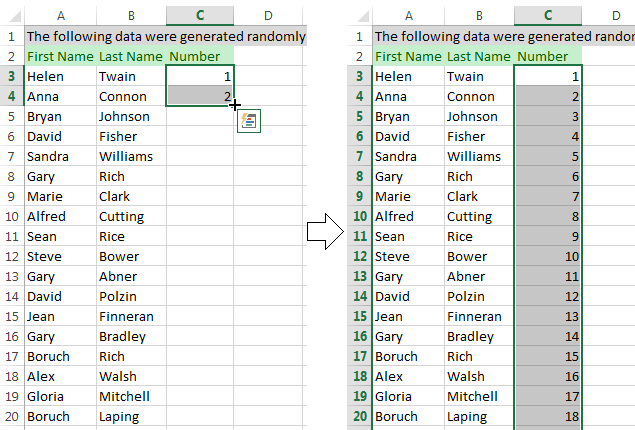How To Generate Serial Numbers In Excel Automatically
Hi Adell, Is it possible to make a randome number set thro entire sheet: i tried the following formula: [=LARGE(ROW($1:$65535)*NOT(COUNTIF($C$1:C1,ROW$1:$65535))),RANDBETWEEN(1,65536-ROW(C1)))] but it seems not working: whenever i try to edit your formulla n ammmend it according to my own chice, it gives error as '#NUM!' And when i pres ctrl+shift+enter, it gives this error '#VALUE!' , can you pls explain wht needs to be done to do it or can you pls make for me and send on: Thanks in advance.
In Excel 2003, when I copy your formula into the formula bar, (cell A2), and use CTRL-SHIFT-ENTER, I get #VALUE! For a result. When I copy the cell directly from your worksheet, (in that case cell B3), and paste it into a blank worksheet, it works fine. Examining that formula it shows #VALUE!

Sometimes you may need to insert some special sequential numbers, such as 000-001, or with other suffix and prefix. Here we are going to guide you how to quickly create or insert sequence numbers in Excel. Insert unique sequence number in Excel as 1, 2, 3, Customize and insert unique sequence numbers with suffix. Excel Dates How to Work with Dates Before 1900 in Excel If you work with dates prior to 1900, Excel offers little direct help. However, some Excel formulas and a free.

For 'RANDBETWEEN(1,11-ROW(A1))', but still works. If I click on the formula bar and then CTRL-SHIFT-ENTER, that formula stops working and returns #VALUE! I can work around it by replacing ROW(A1) by 1, ROW(A2) by 2, etc.; or 11-ROW(A1) by 10,,etc. – but for sanity's sake, I would like to know what Excel magic you use to make your formula work. Hi, I am trying to use the 'unique random text strings' to make random pairs of students in my classroom. However: I have downloaded the example file, and while it works perfectly when I open it (I press F9 and get the states randomly sorted again and again), whenever I access the formula I get the #N/A error. I am on Excel 2007, norwegian language pack. Crosscurrents Reading In The Disciplines Pdf Reader.
All I have to do is click with my mouse in the formula line (like if I wanted to edit the formula) and press enter, and I get error. What is it that changes when I try to edit the formula?
I get a cringe whenever a Help Desk provides the same password, over and over, or minor variations like “1” and “2”. To make it even more random, you can replace some of the CHAR(RANDOMBETWEEN())/RANDBETWEEN() statements with the following CHOOSE(RANDBETWEEN(1,4),RANDBETWEEN(0,9),CHAR(RANDBETWEEN(65,90)),CHAR(RANDBETWEEN(97,122)),CHAR(RANDBETWEEN(33,47))) This randomizes which part of the character set is used at different positions. Warning: If you replace all of the CHAR(RANDOMBETWEEN())/RANDBETWEEN() statements with the above you will end up, at times, passwords without sufficient strength, e.g. That is true. However, leaving the formula as was provided will always keep numbers, letters, symbols in the same position.
Technically it isn’t truly random, but it generates enough of a mixed up set of characters, numbers, and symbols to be useful for this purpose. The good thing about this is if you end up with a password that is insufficient or you just don’t like for some reason, you can refresh until you get one that works. For example, you might get a lowercase letter “l”, which may confuse people since it might look like the number “1” or uppercase “I”. To refresh the string, click on the Formulas tab, then click the Calculate Now button in the Calculate group.
I’m glad this helped. Just note that it is possible using this method to duplicate values if used repeatedly. Datalogic Quickscan M2 Driver Download on this page. It is a truly random selection, so the tracking number 1-111-11111 has an equal chance of being generated the next time the formula is run as it did the first time the number was generated. If duplicates are acceptable (although with the range of numbers you’re using they are not very likely), then this method will work fine. If not, you may want to try sequential numbering to avoid duplicates. It really depends on how many characters you are using in your strings.
If you’re using the example code to generate an 8 character string we’re looking at 1st character: 10 possible outcomes (0-9) 2nd character: 26 possible outcomes (A-Z) 3rd character: 26 possible outcomes (a-z) 4th character: 15 possible outcomes (various symbols) 5th character: 10 possible outcomes (0-9) 6th character: 26 possible outcomes (A-Z) 7th character: 26 possible outcomes (a-z) 8th character: 15 possible outcomes (various symbols) Obviously the more characters you add, the more combinations are available before you start to see duplicates. Unless you’re filling an entire worksheet with random combinations like this, you probably won’t be running into duplicates very often. My guess is you’d hit memory limits before you hit a duplicate though. If you do, I suppose you could add a 9th character?